Corticosterone influences gerbil (Meriones unguiculatus) prostatic morphophysiology and alters its proliferation and apoptosis rates
- PMID: 28664583
- PMCID: PMC5573771
- DOI: 10.1111/iep.12232
Corticosterone influences gerbil (Meriones unguiculatus) prostatic morphophysiology and alters its proliferation and apoptosis rates
Abstract
Glucocorticoids (GCs) are hormones that are widely used in medicine; but although side effects are generally recognised, little is known about the precise mechanisms that is implicated in many of these side effects. Furthermore, GCs are highly correlated with stress and behaviour disorders. This study evaluated the effects of the glucocorticoid corticosterone on the ventral prostate of the Mongolian gerbil. Male gerbils (Meriones unguiculatus) (n = 5) received intraperitoneal injections of saline or corticosterone in doses of 0.5 mg/kg/day and 1.5 mg/kg/day for 5 days; while some of the animals were killed immediately after the treatment, the others were killed 5 days after the treatment period. The data show that corticosterone influences the structure and functionality of this organ. This hormone has anti-proliferative and anti-apoptotic properties in the prostate. In addition, the frequencies of the androgen (AR), oestrogen (ERα, ERβ) and glucocorticoid (GR) receptors changed. The frequencies of AR, GR and ERβ decreased in the Ct1/5 group; in the groups with rest period, the frequencies of GR increased and ERβ decreased in the epithelium. Changes in the proliferative index, apoptotic index and receptor activity may have contributed to the emergence of prostatic morphological alterations, such as the presence of cellular debris and inflammatory cells. Different doses of corticosterone had variable effects on the prostate, with a higher dose showing subtler effects and a lower dose showing more striking effects. The corticosterone effects on nuclear receptors were reverted or attenuated after a rest period, which was not observed for proliferation and apoptosis. In summary, we have demonstrated that corticosterone might influence the prostatic morphophysiology and that these changes may be linked in some way to the altered receptor distribution.
Keywords: corticosterone; gerbil; glucocorticoids; ventral prostate.
© 2017 The Authors. International Journal of Experimental Pathology © 2017 International Journal of Experimental Pathology.
Figures





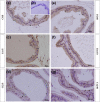
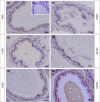
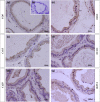
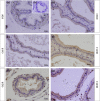
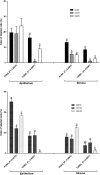
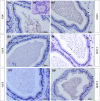
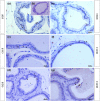
Similar articles
-
Coconut Oil Mitigates the Effects of Aging on the Mongolian Gerbil Prostate.Prostate. 2025 Mar;85(4):395-406. doi: 10.1002/pros.24842. Epub 2024 Dec 24. Prostate. 2025. PMID: 39718211
-
Acute exposure to bisphenol A and cadmium causes changes in the morphology of gerbil ventral prostates and promotes alterations in androgen-dependent proliferation and cell death.Environ Toxicol. 2017 Jan;32(1):48-61. doi: 10.1002/tox.22211. Epub 2015 Nov 5. Environ Toxicol. 2017. PMID: 26537420
-
Paradoxical sleep deprivation and restriction promote castration-like effects and local inflammatory responses in male gerbil prostate.J Biosci. 2024;49:77. J Biosci. 2024. PMID: 39119912
-
Cellular and extracellular behavior in the gerbil (Meriones unguiculatus) ventral prostate following different types of castration and the consequences of testosterone replacement.Cell Biol Int. 2007 Mar;31(3):235-45. doi: 10.1016/j.cellbi.2006.10.006. Epub 2006 Oct 18. Cell Biol Int. 2007. PMID: 17123842
-
Tissue evidence of the testosterone role on the abnormal growth and aging effects reversion in the gerbil (Meriones unguiculatus) prostate.Anat Rec A Discov Mol Cell Evol Biol. 2006 Nov;288(11):1190-200. doi: 10.1002/ar.a.20391. Anat Rec A Discov Mol Cell Evol Biol. 2006. PMID: 17031809
Cited by
-
Condyloma acuminata: An evaluation of the immune response at cellular and molecular levels.PLoS One. 2023 Apr 13;18(4):e0284296. doi: 10.1371/journal.pone.0284296. eCollection 2023. PLoS One. 2023. PMID: 37053156 Free PMC article.
References
-
- Andersen ML, Ribeiro DA, Bergamaschi CT et al (2009) Distinct effects of acute and chronic sleep loss on DNA damage in rats. Prog.Neuropsychopharmacol. Biol. Psychiatry 33, 562–567. - PubMed
-
- Behmer A.O., Tolosa E.M.C. & Neto A.G.F. (1976) Manual de praticas para histologia normal e patologica. São Paulo, Brazil: Edart‐Edusp.
-
- Bland R., Worker C.A., Noble B.S. et al (1999) Characterization of 11b‐hydroxysteroid dehydrogenase activity and corticosteroid receptor expression in human osteosarcoma cell lines. J. Endocrinol. 161, 455–464. - PubMed
-
- Bruni‐Cardoso A., Vilamaior P.S., Taboga S.R. & Carvalho H.F. (2008) Localized matrix metalloproteinase (MMP)‐2 and MMP‐9 activity in the rat ventral prostate during the first week of postnatal development. Histochem. Cell Biol. 129(6), 805–815. - PubMed
Publication types
MeSH terms
Substances
LinkOut - more resources
Full Text Sources
Other Literature Sources
Research Materials

